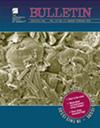侏罗纪地层的碎屑锆石揭示了鄂尔多斯盆地北部的演化和铀矿化过程
IF 3.9
1区 地球科学
Q1 GEOSCIENCES, MULTIDISCIPLINARY
引用次数: 0
摘要
具有复杂演化历史的稳定沉积盆地通常会形成各种表生资源,如砂岩型铀矿床。然而,盆地演化与后续铀矿化之间的遗传联系仍不清楚。碎屑锆石是一种坚固的矿物,其铀-铅年代和lu-Hf同位素对于追踪沉积盆地的演化过程至关重要。鄂尔多斯盆地是华北克拉通最大的大陆内盆地和铀矿区。它由寒武系至奥陶系海相沉积和石炭系至侏罗系陆相沉积组成,陆相碎屑岩序列的起源主要受邻近造山带的影响。本研究提供了鄂尔多斯盆地北部侏罗系直罗构造砂岩的新的全岩元素数据、锆英石U-Pb年龄和Lu-Hf同位素。这项研究利用该盆地和中亚造山带南部古生代沉积岩的数据,旨在确定沉积物的产地、鄂尔多斯盆地北部的演化以及对铀矿化的潜在影响。来自直罗构造的碎屑锆石一般呈圆形,并保留了岩浆分带结构。它们的年龄显示出四个群体:330-245Ma、470-350Ma、2100-1650Ma和2750-2200Ma,与北面的中亚造山带和阴山带以及西北面的阿拉善地块的构造热事件相一致。其锆英石年龄和εHf(t)值与下伏沉积岩相似。此外,地层中还有回收的碳质碎屑、多种碎屑和三叠纪化石,其砂岩的成分变异指数值较低(0.79-0.97),SiO2/Al2O3(5.33-7.25)和Th/Sc(0.71-1.97)比值较高。这些证据表明,直罗地层的碎屑岩部分来源于下伏沉积地层。值得注意的是,鄂尔多斯盆地北部古生代至中生代地层的锆英石年龄模式和εHf(t)值也与中亚造山带南部相似,因此,鄂尔多斯盆地的世俗演化被认为是受古生代亚洲洋俯冲、中亚造山带与华北克拉通碰撞以及碰撞后地壳延伸的控制。直罗构造中的碳质碎屑为随后的还原矿物结晶和铀矿化提供了还原环境。本文章由计算机程序翻译,如有差异,请以英文原文为准。
Evolution and uranium mineralization of the northern Ordos Basin revealed by detrital zircons of the Jurassic strata
Stable sedimentary basins with complex evolutionary histories generally develop various epigenetic resources, such as sandstone-type uranium deposits. However, the genetic linkage between basin evolution and subsequent uranium mineralization remains unclear. Detrital zircon is a robust mineral, and its U-Pb ages and Lu-Hf isotopes are essential for tracing the evolution of sedimentary basins. The Ordos Basin is the largest intracontinental basin and uranium deposit region in the North China Craton. It consists of Cambrian to Ordovician marine deposits and Carboniferous to Jurassic terrestrial successions, and the origins of the terrigenous clastic sequences are dominantly influenced by the neighboring orogenic belts. This study presents new whole-rock elemental data, detrital zircon U-Pb ages, and Lu-Hf isotopes for the sandstones from the Jurassic Zhiluo Formation of the northern Ordos Basin. With data from the Paleozoic sedimentary rocks of the basin and the southern Central Asian Orogenic Belt, this study aimed to determine sediment provenances, the evolution of the northern Ordos Basin, and the potential implications for uranium mineralization. Detrital zircons from the Zhiluo Formation are generally rounded and preserve magmatic zoning structures. Their ages display four populations, 330−245 Ma, 470−350 Ma, 2100−1650 Ma, and 2750−2200 Ma, which are consistent with the tectono-thermal events of the Central Asian Orogenic Belt and the Yinshan Belt to the north, and the Alxa Block to the northwest. Both their detrital zircon ages and εHf(t) values are similar to those of the underlying sedimentary rocks. In addition, the formation has recycled carbonaceous debris, diverse clastic fragments, and Triassic fossils, and its sandstones show low index of compositional variability values (0.79−0.97) and high SiO2/Al2O3 (5.33−7.25) and Th/Sc (0.71−1.97) ratios. These lines of evidence suggest that the detritus of the Zhiluo Formation was partially derived from the underlying sedimentary strata. It should be noted that the Paleozoic to Mesozoic strata of the northern Ordos Basin also have detrital zircon age patterns and εHf(t) values similar to those of the southern Central Asian Orogenic Belt, and the secular evolution of the Ordos Basin is therefore considered to have been controlled by subduction of the Paleo-Asian Ocean and collision between the Central Asian Orogenic Belt and the North China Craton, as well as the post-collisional crustal extension that ensued. The carbonaceous debris in the Zhiluo Formation provided a reductive environment for the subsequent crystallization of reducing minerals and uranium mineralization.
求助全文
通过发布文献求助,成功后即可免费获取论文全文。
去求助
来源期刊

Geological Society of America Bulletin
地学-地球科学综合
CiteScore
9.30
自引率
8.20%
发文量
159
审稿时长
4-8 weeks
期刊介绍:
The GSA Bulletin is the Society''s premier scholarly journal, published continuously since 1890. Its first editor was William John (WJ) McGee, who was responsible for establishing much of its original style and format. Fully refereed, each bimonthly issue includes 16-20 papers focusing on the most definitive, timely, and classic-style research in all earth-science disciplines. The Bulletin welcomes most contributions that are data-rich, mature studies of broad interest (i.e., of interest to more than one sub-discipline of earth science) and of lasting, archival quality. These include (but are not limited to) studies related to tectonics, structural geology, geochemistry, geophysics, hydrogeology, marine geology, paleoclimatology, planetary geology, quaternary geology/geomorphology, sedimentary geology, stratigraphy, and volcanology. The journal is committed to further developing both the scope of its content and its international profile so that it publishes the most current earth science research that will be of wide interest to geoscientists.
 求助内容:
求助内容: 应助结果提醒方式:
应助结果提醒方式:


